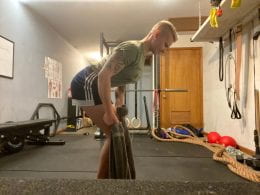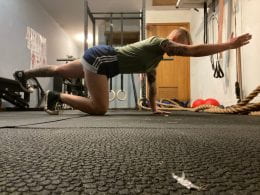Review

To rehash some essentials from pt 1:
Strength: The ability to generate maximum external force on an object
Speed: Velocity of body motion
Power: Force produced x velocity of the movement
(power can also be defined as the rate of performing work)
Peak Power = happens at around 1/3 maximum velocity
(The peak power of a muscle fiber typically occurs around 15% to 30% of that muscle fiber’s maximal force capacity. )
Power is important because its expression is essential to success in many sports: throwing, punching, jumping, sprinting, changing directions, etc all require power output, and typically the more you’re able to produce the better you’ll perform.
An athlete’s Rate of Force Development is a way to refer to their capacity for producing power.
Training adaptation is specific to the stress imposed on the athlete. This is the SAID principle, Specific Adaptation to Imposed Demands. So if we want a powerful punch or a powerful jump we will need to train the body-part(s), skills, and movement specifically. We need to train the energy systems, tissues (strength, endurance, and volume tolerance), and nervous system at the proper dosages to elicit power gains.

Training To Improve Power
Now that we’ve reviewed our definitions and refreshed our memory regarding physiology, stress, and adaptation we can dive right in on how to train to improve power output.
Training to improve power requires that we bring into consideration the training experience and performance level of the client (or ourselves for that matter). For example, if I’m training middle school basketball players I likely will not need to use the volume and intensity that I need to use with more developed college aged athletes. The less trained an individual is, the easier it is to make gains with simple exercises performed well and with sufficient frequency.
For the purposes of this article we’re going to aim right down the center on training experience. If you’re brand new to training, improving your power can likely be done with simple exercises, if you’re very experienced this article may also fall outside of your needs as you may need a more complex program to gain power.
First Things First
In order to know if our training is effective we must first establish a baseline. Professional strength coaches have many ($$$ costly!) ways of measuring and assessing the power, force, and velocity profiles of individual athletes but mean power, peak power, velocity of a movement, and force of a movement are some of the most commonly measured variables.
Because most trainees don’t have access to an elite training facility and the equipment to measure these variables, they can establish base line numbers from indirect tests and some simple math. The vertical jump alone does not render us a number that directly represents power so we can utilize the Sayers Power Equation to calculate power output in watts.This way if our body mass changes over the program we can still understand power gains or losses – provided the way we measure vertical jump height is consistent.
PAPw(Watts) = 60.7 x jump height (cm) + 45.3 x Body Mass (kg) – 2055
(keep in mind the equation uses the metric system – google will convert numbers for you! )
For our upper body we can easily indirectly measure power with a medicine ball chest pass by measuring distance. Keep in mind, the mass of the ball and our body position must be consistent across test and retest for this to be accurate.
Developing a plan of attack
Going back to the first article, we touched on a few necessary components to power which were as follows; muscle size, neuromuscular capacity for power and max strength, and the SAID (specific adaptation to imposed demands) principle. When we train we need to keep these three things in mind when we organize our training cycle.
If you’re a strength or single event athlete prepping for a competition your training will look different than if you’re an athlete with a pre/on/post/off season organization. Regardless, we want to train so that we are able to express our power at the time of the year we most need it for our sport. (If you’re a general fitness enthusiast, I would encourage you to set goals and train specifically for them even if you aren’t interested in competition as it provides structure and direction.)
The nitty gritty details regarding organization of sports training are outside the scope of this article but to give us a loose context, training can be organized into the following structure:
Macrocycle:
- generally your entire training year, this focuses on improving performance for the peaking before a major event, or getting a broad overview of your sport season. Because a year is so long there are typically adjustments along the way, but understanding what skills you need to train when, how well you might be prepared to recover, and how much competitive work you’ll be doing is important.
Mesocycle:
- This is usually a several week chunk of time, one example might be a 4 week training phase focusing on peaking for a powerlifting competetion. There are many mesocycles in a macrocycle.
Microcycle:
- Most training plans keep the microcycle within the confines of a 7 day week, this encompasses the workouts for the week.
There are many kinds of programming, most utilize periodization of exercises in either a linear (increasing intensity/ & reducing volume), block (one skill at a time rotating in sequence), undulating (varying volume/intensity in waves over time), conjugate (concurrent training of multiple skills at once), or combination of the methods above format.
For now, we are going to simply focus on building one mesocycle with 4 x 1 week microcycles that prioritizes power but still maintains our strength and some of our capacity for volume (concurrent training).
The Exercises
These exercises typically require a higher skill level and are rather fatiguing. We usually place them at the beginning of a session after our soft tissue and dynamic warmups. These exercises impact the nervous system significantly and cover the neuromuscular power component of our three priorities.
- Olympic lifts such as the clean, snatch, jerk and their variations
- Very explosive KB swings
- Jumps and loaded jumps
- Ballistic movements such as those done explosively with bands or chain
- Medicine ball throws
Typically we keep the rep range relatively low (1-5) for power exercises as it is important to maintain the coordination and speed of the movements. Excessive fatigue from high reps limits how much power gain we can achieve. This is why very high rep olympic lifts and very high rep jumps make little sense as we may be detraining our capacity for power in the name of conditioning. There are many better ways to build conditioning that don’t limit our power on big movements!
Total sets are typically slightly higher when reps are very low with 4×5, 6×3, and 8×2 all being popular set/rep schemes.
Our intensity will also be relatively low likely starting out around 30% of maximum force capacity. For example, 30lbs for speed squats if our max squat is 100lbs.
Strength Exercises:
These exercises are programmed to maintain the strength and muscle mass to generate power throughout the program. They are typically done as a secondary primary exercise after our primary power exercise. These exercises cover both the neuromuscular strength component and to a slightly lesser degree the size component.
- Front squats
- Back squats
- Bench, flat, incline, etc
- Barbell rows
- etc….
Rep ranges here will still be relatively low similar to our power exercises (3-6 reps), however our total sets will most likely start at 3 sets and our beginning intensity will start around 70%.
Accessory/Volume Exercises
These are the exercises we use to maintain core strength, local muscular endurance and overall capacity for volume. Think lighter barbell movements, dumbbells, bodyweight, etc with lighter loads and higher reps for moderate sets. 2-4 exercises should be sufficient and exercise selection will generally be based on supporting the main lifts and bringing up any individual weaknesses. These focus in part on the size component, keep up some lower intensity volume, let us keep certain body parts healthy/balanced (think postural exercises, bird dogs, band pull-aparts, etc), and let us bring weak parts up.
This part could be as simple as a leg day being followed by a tri-set of walking lunges, side planks, and hip thrusters, a kettlebell complex, or a bodyweight exercise circuit finisher.
Putting it all together (finally!)
Let’s imagine for a moment that Suzie has just graduated college, she was a competitive NCAA soccer athlete for her entire time in school, and now that she’s in the big kid world of full time jobs, loan payments, and being on her own insurance she doesn’t have much time to train. She figures that she can really only train 3 days a week for about an hour at a time. Her old vertical jump height was about 16 inches which, according the the NSCA’s is about average for a college female soccer player. Currently she weighs 130lbs.
Her jump in cm = 40.64 cm
her mass in kg = 58.97
Her peak anaerobic power output =
PAPw(Watts) = (60.7 x 40.64) + (45.3 x 58.97) – 2055
= 3,083.19 Watts
With 3 days a week to train Suzie can organize her training as follows:
Day 1: Highest intensity day of the week, moderate volume
Day 2: Lowest intensity day of the week, moderate volume
Day 3: Mid-High intensity, moderate volume
Finally, she comes up with the program below:

After 8 weeks of following her program, Suzie retests her vertical jump!
She jumps 17 inches after the program and has gained some lean mass over the course of it too. Now she weighs 134 lbs instead of 130.
Her new height in cm = 43.18
Her new weight in kg = 60.78
PAPw(Watts) = (60.7 x 43.18) + (45.3 x 60.78) – 2055
Her new peak power output is:
3319.36 Watts
Her gain = (3319.36 Watts – 3,083.19 Watts) = 236.17 Watts!
Program? = SUCCESS!
Sources
1.
Bondarchuk, A. P.,
& Yessis, M. (2007). Transfer of training in sports. Michigan:
Ultimate Athlete Concepts.
2.
Boyle, M.
(2016). New functional training for sports. Champaign, IL: Human
Kinetics.
3.
Hoffman, J. R.
(2012). NSCAs guide to program design. Champaign, IL: Human
Kinetics.
4.
NSCA -National
Strength & Conditioning Association. (2017). Developing Power.
Human Kinetics Publishers.
5.
Parker, J., Miller,
A., Panariello, R., & Hall, J. (2018). The system: Soviet
Periodization adapted for the American strength coach. Aptos, CA: On Target
Publications.
6.
Zatsiorsky, V. M.,
& Kraemer, W. J. (2006). Science and Practice of Strength Training.
Champaign, ILL.: Human Kinetics.






















